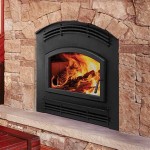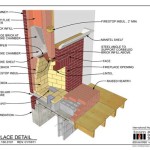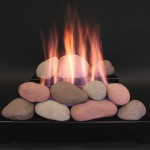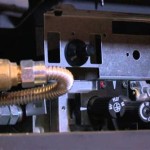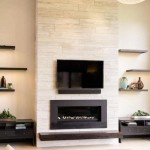Natural Gas Fireplace Insert With Blower: Enhanced Heating and Efficiency
A natural gas fireplace insert with a blower represents a significant upgrade to a traditional fireplace, offering improved heating efficiency, convenience, and aesthetic appeal. By transforming an existing masonry fireplace into a zone-heating appliance, these inserts provide a cost-effective and practical solution for homeowners seeking to supplement their primary heating system and create a cozy ambiance.
Fireplace inserts are self-contained units designed to fit directly into the opening of an existing wood-burning fireplace. They typically feature a metal firebox, a ceramic or refractory lining, and a glass front panel. The natural gas version utilizes natural gas as its fuel source, eliminating the need for wood storage and handling. The integrated blower system is a key component that significantly enhances the insert's heating capabilities.
The operational principle of a natural gas fireplace insert with a blower involves combustion of natural gas within the firebox, generating heat. This heat radiates from the glass front and warms the surrounding air. The blower, typically a variable-speed fan, draws cool air from the room, circulates it around the firebox, and then forces the heated air back into the room. This forced-air circulation dramatically improves the heat distribution and efficiency compared to a traditional fireplace, where much of the heat escapes up the chimney.
Natural gas fireplace inserts are available in a wide variety of designs, sizes, and styles to complement different home décor preferences. They can range from traditional models that mimic the appearance of a wood-burning fire to more contemporary designs with sleek lines and modern finishes. The choice of insert will depend on the size of the existing fireplace opening, the desired heating capacity, and the homeowner's aesthetic preferences.
Key Benefits of Natural Gas Fireplace Inserts with Blowers
Natural gas fireplace inserts with blowers offer several compelling advantages over traditional fireplaces and other heating options. These benefits contribute to increased comfort, cost savings, and overall home value.
Enhanced Heating Efficiency: One of the primary benefits is significantly improved heating efficiency. Traditional fireplaces are notoriously inefficient, with a large percentage of the heat generated escaping up the chimney. A natural gas fireplace insert, particularly one with a blower, can increase heating efficiency to 70-80% or even higher. This means more of the heat produced is directed into the room, reducing energy waste and lowering heating bills. The blower plays a critical role in this enhanced efficiency by actively circulating the heated air and preventing it from stagnating around the fireplace.
Zone Heating Capabilities: Natural gas fireplace inserts are ideal for zone heating, allowing homeowners to focus heating efforts on specific areas of the home. By using the insert to heat the rooms where occupants spend the most time, such as the living room or family room, the central heating system's workload can be reduced. This can lead to substantial energy savings, as the entire house does not need to be heated to maintain comfort in specific areas. The blower ensures that the heat is effectively distributed throughout the designated zone.
Convenience and Ease of Use: Compared to wood-burning fireplaces, natural gas fireplace inserts offer unparalleled convenience. There is no need to purchase, store, and haul wood, nor is there any ash to clean up. Most natural gas inserts come with remote controls or thermostats, allowing homeowners to easily adjust the flame height, blower speed, and room temperature. The push-button or remote-controlled ignition eliminates the need for kindling and matches, making operation simple and hassle-free. This convenience makes them a practical and appealing heating solution for busy homeowners.
Factors to Consider When Choosing a Natural Gas Fireplace Insert
Selecting the right natural gas fireplace insert with a blower requires careful consideration of several factors. Evaluating these aspects will ensure that the chosen insert meets the homeowner's needs and expectations.
Size and Heat Output: The size of the existing fireplace opening is a primary factor in determining the appropriate size of the insert. It is crucial to measure the height, width, and depth of the fireplace to ensure a proper fit. The heat output, measured in British Thermal Units (BTUs), should be appropriate for the size of the room or area to be heated. An undersized insert may not provide sufficient heat, while an oversized insert may overheat the space and waste energy. Manufacturers typically provide BTU ratings and recommended heating areas for their inserts.
Blower Capacity and Control: The blower capacity, measured in cubic feet per minute (CFM), determines the amount of air that the blower can circulate. A higher CFM rating indicates a more powerful blower, which can effectively distribute heat over a larger area. Variable-speed blowers offer greater control over the airflow and noise levels. Some models also feature automatic blower control, which adjusts the blower speed based on the firebox temperature. This feature maximizes efficiency and prevents the blower from operating when the firebox is not generating sufficient heat.
Venting Requirements: Natural gas fireplace inserts require proper venting to safely exhaust combustion byproducts. Most inserts use a flexible aluminum liner that is run up the existing chimney. The venting system must be installed according to the manufacturer's instructions and local building codes. Proper venting is essential for preventing carbon monoxide poisoning and ensuring the safe and efficient operation of the insert. It's critically important to have a qualified professional inspect and install the venting system.
Installation and Maintenance
Proper installation and regular maintenance are crucial for the safe and efficient operation of a natural gas fireplace insert with a blower. It is strongly recommended to have a qualified professional install the insert and venting system to ensure compliance with safety codes and manufacturer's specifications.
Installation typically involves removing any existing fireplace damper, cleaning the fireplace, installing the venting liner, connecting the gas line, and securing the insert in place. The gas line connection should be performed by a licensed gas fitter to ensure a leak-free and safe installation. After installation, it is essential to test the insert and venting system to verify proper operation.
Regular maintenance should include cleaning the glass front, inspecting the venting system, and checking the blower motor. The glass front can be cleaned with a specialized fireplace glass cleaner to remove soot and residue. The venting system should be inspected annually for any signs of damage or deterioration. The blower motor may require periodic cleaning to remove dust and debris, which can affect its performance. Consult the manufacturer's instructions for specific maintenance recommendations.
The cost of a natural gas fireplace insert with a blower can vary depending on the size, features, and brand. The total cost will also include installation fees, venting materials, and any necessary gas line modifications. While the initial investment may be higher than a traditional fireplace, the long-term energy savings and convenience can offset the initial cost. Additionally, a natural gas fireplace insert can increase the home's value, making it a worthwhile investment.
In conclusion, a natural gas fireplace insert with a blower provides a practical and efficient heating solution for homeowners seeking to upgrade their existing fireplace and reduce their energy consumption. By carefully considering the factors outlined above and ensuring proper installation and maintenance, homeowners can enjoy the warmth, comfort, and convenience of a natural gas fireplace insert for many years to come. The advanced features, such as the blower and thermostat control, enhance the overall heating experience and contribute to a more comfortable and energy-efficient home.

35 Ruby Traditional Intellifire Touch Direct Vent Fireplace Insert Blower And Remote Electronic Ignition Majestic

30 Ruby Contemporary Intellifire Touch Direct Vent Fireplace Insert Blower And Remote Electronic Ignition Majestic

25 Ruby Traditional Intellifire Touch Direct Vent Fireplace Insert Blower And Remote Electronic Ignition Majestic

Duluth Forge 36 In Ventless Dual Fuel Fireplace Insert With Remote Control Fdi32r The Home Depot

Gas Fireplace Inserts At Com

Breckwell Large Direct Vent Fireplace Insert Bh2818i Hvacdirect Com

Monessen Direct Vent Gas Fireplace Insert Reveal

Kozy Heat Fireplaces And Inserts Portland Or Nw Natural Appliance Center
:max_bytes(150000):strip_icc()/ventless-gas-fireplaces-4160746-hero-f9d4bdcd9bd446eb84406de306f790ba.jpg?strip=all)
How To Pick Out A Ventless Gas Fireplace

Fireplace Inserts Everything You Need To Know Full Service Chimney

